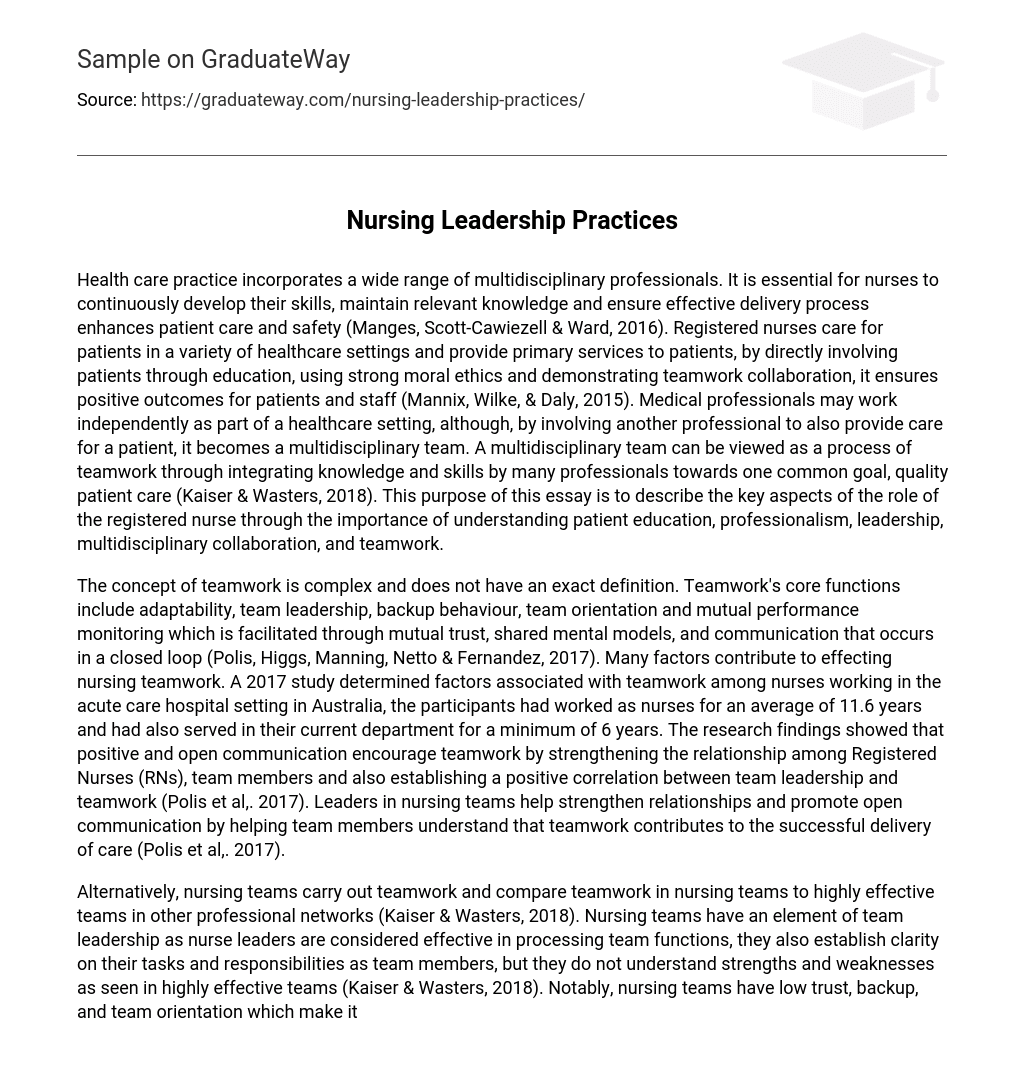Health care practice incorporates a wide range of multidisciplinary professionals. It is essential for nurses to continuously develop their skills, maintain relevant knowledge and ensure effective delivery process enhances patient care and safety (Manges, Scott-Cawiezell & Ward, 2016). Registered nurses care for patients in a variety of healthcare settings and provide primary services to patients, by directly involving patients through education, using strong moral ethics and demonstrating teamwork collaboration, it ensures positive outcomes for patients and staff (Mannix, Wilke, & Daly, 2015). Medical professionals may work independently as part of a healthcare setting, although, by involving another professional to also provide care for a patient, it becomes a multidisciplinary team. A multidisciplinary team can be viewed as a process of teamwork through integrating knowledge and skills by many professionals towards one common goal, quality patient care (Kaiser & Wasters, 2018). This purpose of this essay is to describe the key aspects of the role of the registered nurse through the importance of understanding patient education, professionalism, leadership, multidisciplinary collaboration, and teamwork.
The concept of teamwork is complex and does not have an exact definition. Teamwork’s core functions include adaptability, team leadership, backup behaviour, team orientation and mutual performance monitoring which is facilitated through mutual trust, shared mental models, and communication that occurs in a closed loop (Polis, Higgs, Manning, Netto & Fernandez, 2017). Many factors contribute to effecting nursing teamwork. A 2017 study determined factors associated with teamwork among nurses working in the acute care hospital setting in Australia, the participants had worked as nurses for an average of 11.6 years and had also served in their current department for a minimum of 6 years. The research findings showed that positive and open communication encourage teamwork by strengthening the relationship among Registered Nurses (RNs), team members and also establishing a positive correlation between team leadership and
teamwork (Polis et al,. 2017). Leaders in nursing teams help strengthen relationships and promote open communication by helping team members understand that teamwork contributes to the successful delivery of care (Polis et al,. 2017).
Alternatively, nursing teams carry out teamwork and compare teamwork in nursing teams to highly effective teams in other professional networks (Kaiser & Wasters, 2018). Nursing teams have an element of team leadership as nurse leaders are considered effective in processing team functions, they also establish clarity on their tasks and responsibilities as team members, but they do not understand strengths and weaknesses as seen in highly effective teams (Kaiser & Wasters, 2018). Notably, nursing teams have low trust, backup, and team orientation which make it different from highly effective teams that value mutual trust, togetherness, and understanding of each other’s weaknesses and strengths (Kaiser & Wasters, 2018). Hence, there is a need for nursing teams to have a higher understanding such as being aware of other team members and embracing backup behaviour to improve their performance (Kaiser & Wasters, 2018).
Having identified the limitations of teamwork, nurse leaders can facilitate the growth of a high performing team by executing an initiative on patient safety (Manges et al,. 2016). Nurse leaders should identify members who are qualified to be in the team to resolve all conflicts, support the project, and add new members to the initiative without compromising the performance of the team (Manges et al,. 2016). Research through RNs team training that is aimed at enhancing patient outcomes by implementing the inter-professional team intervention, the participants reported that the training helped them to open up more due to open communication and strengthened relationships whereby they gained awareness about other team members (Baik & Zierler, 2018). The interprofessional team intervention, therefore, enhanced patient outcome as a result of better communication.
Leadership is growing among RNs because it helps them adapt to the fast-evolving healthcare environments which cause technological, social, economic and academic challenges (Scully, 2015). Leadership is essential in nursing teams as it promotes, motivation, and direction towards a common goal, notably, leadership is a concept that does not have to be related to an authority (Scully, 2015). At the same time, leadership entails a process of supporting team members and inspiring followers to establish relationship rapport with each other, develop their talents, and execute the tasks that nurse leaders delegate to them (Scully, 2015).
The role of RNs in promoting leadership in nursing practice is to understand the constantly changing environment and to find ways of helping team members adapt to new environments, such nurse leaders practice transformational leadership. (Scully, 2015). Connective leadership also helps RN leaders and team members to share leadership activities depending on their needs and current situation. This type of leadership promotes interdependence and helps RNs complete their tasks while solving challenges without constant supervision (Scully, 2015). Importantly, leadership that boosts morality helps RN leaders to promote ethically right clinical practices and identifies aesthetic leadership as a key leadership style for clinical leaders (Mannix et al,. 2015). Having a leadership approach helps RN leaders to uphold values that improve morality which in turn, helps team members carry out clinical work with a strong moral purpose and it promotes teamwork.
Additionally, through aesthetic leadership, RN leaders enhance nursing practice by helping team members to solve situations of ethical problems (Mannix et al,. 2015). The role of a RN leader in a healthcare team is to create a high performing team that can work together to ensure safe patient care, leaders also have to create efficient teams by recruiting and training qualified team members and ease tension as problems arise (Manges et al., 2016). Nurse leaders must also help team members to familiarise group standards before they can move to the next stage (Manges et al., 2016). RNs, therefore, rely on effective nursing leadership practices to improve team performance, contributing to the delivery of patient care.





